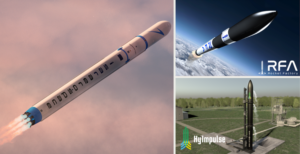After securing its first contract with sister company OHB Sweden AB on March 31 for the launch of a single mission, Rocket Factory Augsburg announced April 27 that it had signed launch contracts with OHB Cosmos and LuxSpace for missions in mid-2024 and 2025. The companies did not identify payloads for the two dedicated launches.
Rocket Factory Augsburg, the launch arm of German space technology company OHB SE, is developing its three-stage RFA One launch vehicle, which is designed to carry 1,300 kilograms to a 300-kilometer polar orbit. The vehicle is slated for maiden launch in 2022 from Norway’s Andøya Spaceport.
Isar Aerospace, which aims to debut its two-stage Spectrum rocket from Andøya in 2022, announced its first launch contract April 22. Airbus Defense and Space chose the Munich-based startup to launch a future Earth observation satellite into a sun-synchronous orbit. The contract includes one firm mission with options for additional launches. The companies did not say when the first of these launches would occur.
Isar Aerospace, which counts Airbus Ventures among its investors, is developing the two-stage Spectrum rocket to deliver up to 700 kilograms of payload to sun-synchronous orbit. The company, which aims to debut Spectrum in 2022. recently arranged for exclusive use of one of two launch pads being built at Norway’s Andøya Space Center. The 20-year lease will enable Isar Aerospace to deploy payloads into sun synchronous and polar orbits.
HyImpulse Technologies, meanwhile, is developing the three-stage SL1 launch vehicle, which is designed to carry payloads of up to 500 kilograms to low Earth orbit. The vehicle is expected to make its debut in 2022.
Turning stakeholders into customers
RFA’s April 27 announcement marks the second time that the company has won business from other parts of its parent company OHB SE. OHB Cosmos contracts flights aboard launch vehicles from around the world. Most recently, it managed the launch of the GMS-T communications satellite aboard a Rocket Lab Electron rocket.
OHB-owned LuxSpace, meanwhile, is a microsatellite solutions provider that offers a turnkey satellite platform called the Triton-X, the development of which was co-funded by ESA. The satellite platform can be adapted to a number of applications including communications, Earth observation and as a technology demonstrator.
Like RFA, Isar Aerospace found its first launch customer among its stakeholders. Although Silicon Valley-based Airbus Ventures operates independently of Airbus, the early-stage venture capital company looks for startups with the potential to impact an aerospace industry partially dominated by Airbus.
While Airbus Defense and Space did not disclose the satellite it has in mind for its future Spectrum launch, the company is currently working on at least two Earth observation constellations destined for sun-synchronous orbits.
One of those, Pléiades Neo, will consist of four 750-kilogram satellites, the first of which is slated to launch April 29 on an Arianespace-operated Vega rocket along with five smaller payloads. Airbus plans to use Vega and Avio’s upcoming Vega C to launch the other three Pléiades Neo satellites, which are all too heavy for Spectrum’s advertised 700-kilogram to SSO capacity.
The Composante Optique 3D (CO3D) constellation, a joint undertaking by Airbus and the French space agency CNES, looks like a better fit for Isar Aerospace’s rocket. Although the initial four-satellite CO3D constellation is slated to be launched aboard a Vega C in 2023, Airbus anticipates that the constellation could grow to between 12 and 24 satellites. At 300 kilograms each, these satellites would be well within Spectrum’s projected capabilities to launch two at a time.
A three-way race for ESA funding heats up
In addition to competing to win launch contracts, Isar Aerospace, Rocket Factory Augsburg and HyImpulse Technologies are also taking part in the German Space Agency DLR’s microlauncher competition.
The competition, which is being run in conjunction with ESA, will award one of the three startups with 11 million euros ($13 million) in funding later this year. The funding is to be used to support a qualification flight that will carry a payload for a university or research institution for free. A second prize of 11 million euros in funding will then be awarded in 2022 as the final stage of the competition.
In evaluating the three startups, the DLR panel of judges will examine the technical aspects and commercial feasibility of each launcher. As a result, each startup’s success in securing funding and signing launch contracts will play a role in their chance of winning the competition.
To assist the three launch startups on their road to the launchpad, the European Space Agency awarded each with 500,000 euros in funding in November as part of the agency’s Boost! initiative, an ESA program that aims to foster new commercial space transportation services. The agency adopted Boost! during Space19+, an ESA ministerial-level council meeting held in November 2019, and announced an open call for proposals in April.



